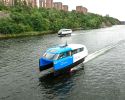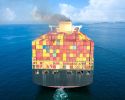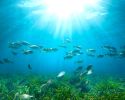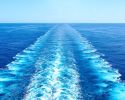Three-year project discusses the sustainable port in three new reports

The innovation project I.Hamn, where small and medium-sized ports have worked towards the vision of the "sustainable port", is finished. So what has happened since its start three years ago? And where are the ports going? RISE researchers Sandra Haraldson and Mikael Lind, who led the project carried out on behalf of the Swedish Transport Administration and Lighthouse, give their view on the matter.
Many Swedish debate articles about the great importance of shipping usually begin with the claim that 90 percent of our imports and exports at some point go via the sea. Of course, this must also mean that a very large part of our merchandise trade takes place via our ports. And now when there is a goal of moving transport from the country's roads to sea and rail the importance of ports cannot be underestimated. Of course, it also places new demands on them, which the innovation project I.Hamn has taken note of - the aim has been to strengthen the innovation capacity of small and medium-sized Swedish ports by facilitating cooperation and development in the areas of digitalisation, electrification and automation. Based on that work, RISE has formulated the concept "The sustainable port".
So what has happened in these three years, does the sustainable port exist today?
“Much of the work within I:Hamn has been about getting the ports' perspective on what the sustainable port is. What role can and should the port have in the future transport system? What skills are required? You could say that we brought the small and medium-sized ports together to give them a stronger voice. Individually, they are too small”, says Sandra Haraldson.
So how do they think?
“Firstly, they want to dispel the myth that the port is only a window to shipping. Today, it is a transport node that connects to all modes of transport that come to visit. They don't have to have anything to do with shipping at all, the port just happens to be located geographically by the water”, says Mikael Lind.
“An expression of that is all the initiatives to have rail capability inside the ports. And the train operators, for example Green Cargo, now place their rail nodes strategically at the ports”, adds Sandra Haraldson.
You write in one of the project's three reports that the ports should become a proactive actor rather than a reactive one. How can you be more proactive?
“The ports are also charging to be energy nodes as a complement to transport nodes, both in light of the fact that a lot of energy is transported via shipping but also because of Fit for 55 and the new regulations that will affect shipping. Here you have the opportunity as a port to be both a link in the energy chain and someone who also provides shore power, alternative fuels and so on”, says Mikael Lind.
He continues:
“Then we have the digital dimension with the port as a digital node. It is something that has completely exploded. An important part of the concept of the sustainable port is based on being more transparent in various ways, and there digitization fulfills an important function for coordination and synchronization, both within the port and between the port and its visitors. At the same time, when we did the research on ports as a digital node, we discovered that very few of them had a digital strategy. It is an expression of having been more reactive.”
Have they been reacting too late and now suddenly things explodes in those areas?
“I think that in a small port you don't have a dedicated resource that works with IT development and digitization, but it is something that is put on someone who has a different role. Then it is very difficult to be proactive. Another aspect is that it is expensive and you don't want to make an investment if you are not sure that it will bring something. That is why it has been so important for the ports to be with the I.Hamn cluster and exchange experiences, like; “we have bought this port system. It works well and gives this and that.” The digital strategy work has clearly ended up higher on the agenda”, says Sandra Haraldson.
She continues:
“We discovered early on in the project that we have to divide the development issues into things that the ports can influence themselves and things that they have no control over. The ports need to wait for the decisions of other actors in order to act.”
The rules in fit for 55 must be a typical such decision that will affect?
“Yes, and much of what the ports will have to do is beyond their control. They have to wait for decisions from other stakeholders, for example around alternative fuels and shore power, which creates some kind of reactivity per se.”
So what is the big challenge for small and medium-sized ports?
“I think it's just about being able to quickly understand what other stakeholders will do, for example how others will respond to Fit for 55, so that the ports can create the necessary infrastructure”, says Sara Haraldson.
“Yes, and I:Hamn has shown that there is no competition between the ports”, says Mikael Lind. “You are simply niched differently. Everyone has their business and you are not afraid of losing it, but it is more about being responsive enough to the demands that others will make.”
“That in combination with developing what you have at your disposal”, says Sandra Haraldson. “There is still much that the ports can do in terms of work machinery, lighting, heating and so on. Combining that work with the more responsive, that's the big challenge, I think.”
Above all, what kind of decisions or needs do the ports have to wait for?
“Fuel types are of course one thing. Standardized sockets for shore power another. Then I think that storage and processing, which the goods owners often put next door or in the port, becomes important. Creating good planning conditions for different types of transport will also be,” says Mikael Lind.
“Another important aspect is that the majority of ports are owned by municipalities and they may not always have the suit to drive development or even have the opportunities to create the right conditions. Therefore, it is important to support the port boards in making the decisions that are commercially important to realize the vision of the sustainable port.”
Read the reports:
-
 NextWave – en podd som ska locka unga
NextWave – en podd som ska locka unga -
 Ny studie: Eldrivna pendelbåtar kan effektivisera Stockholms kollektivtrafik
Ny studie: Eldrivna pendelbåtar kan effektivisera Stockholms kollektivtrafik -
 Sjöfartens utsläpp ökar
Sjöfartens utsläpp ökar -
 Sociala relationer påverkar val av bränsle
Sociala relationer påverkar val av bränsle -
 Sjöfartens omställning kräver ”mjukare” påtryckningar
Sjöfartens omställning kräver ”mjukare” påtryckningar -
 Hon hade avtalad tid med Kapten ynkrygg
Hon hade avtalad tid med Kapten ynkrygg -
 Lighthouse omvärldsanalys 2025 – osäkerhet och tullar präglar sjöfarten
Lighthouse omvärldsanalys 2025 – osäkerhet och tullar präglar sjöfarten -
 Se seminariet Shipping in the Marine Environment
Se seminariet Shipping in the Marine Environment -
 Vad betyder egentligen de 90 procenten?
Vad betyder egentligen de 90 procenten? -
 Hålla där...
Hålla där...

